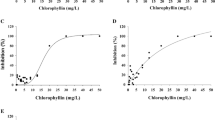Abstract
Photoaldrin, photodieldrin, and photoheptachlor are more toxic than their corresponding parent compounds (aldrin, dieldrin, and heptachlor) to freshwater invertebrates and vertebrates, and to adult houseflies. The increase in toxicity is very significant in the case of the amphipod,Gammarus (1.5–12 times), bluegill fry (3.6–5.7 times), mosquito larvae,Aedas (2.3–6 times), minnow fry (2.5 times), and the isopid,Asellus (2 times). The greatest increases occur with photodieldrin which is 12 and 5 times more toxic than dieldrin, respectively, toGammarus, and to blue-gill fry, and with photoaldrin which is 6 and 4 times more toxic than aldrin, respectively, to mosquito larvae and bluegill fry. The toxicities of the photoisomers of isodrin and chlordene are generally less than those of their parent compounds to all the organisms tested. The basis of the differences in toxicities of the chlorinated cyclodiene photoisomers appears to be related to their chemical structure which possibly affects their action at the site(s) of toxic action and/or detoxication. The acidic proton present at the secondary chloride in photoaldrin, photodieldrin, and photoheptachlor possibly is responsible for the formation of charge-transfer complexes between components of the nerve and the mixed-function oxidase; the latter enzyme apparently dehydrochlorinates these photo products to their corresponding, more toxic ketones. The absence of such protons in photoisodrin and photochlordene renders them incapable of forming such ketones. The inhibition of these reactions by sesamex in house flies increases the stability of the chlorinated cyclodiene insecticides and, thus, significantly affects their toxicity. The conversion of photoaldrin, photodieldrin, and photoheptachlor to more-toxic and lipophilic ketones warrants additional studies of their accumulation and subsequent concentration by the food chain.
Similar content being viewed by others
References
Benson, W. R., P. Lombardo, I. J. Egry, R. D. Ross, R. J. Barron, D. W. Mastbrook, and E. A. Hansen: Chlordane photoalteration products: their preparation and identification. J. Agr. Food Chem.19, 857 (1971).
Georgacakis, E. and M. A. Q. Khan: Toxicity of the photoisomers of cyclodiene insecticides to freshwater animals. Nature233, 120 (1971).
Georgacakis, E., S. R. Chandran, and M. A. Q. Khan: Metabolism-toxicity relationship of the photoisomers of cyclodiene insecticides to aquatic animals. Bull. Environ. Contam. Toxicol.6, 535 (1971).
Henderson, G. L. and D. G. Crosby: Photodecomposition of dieldrin and aldrin. J. Agr. Food Chem.15, 888 (1967).
Khan, M. A. Q., W. Coello, A. A. Khan, and H. Pinto: Some characteristics of the mixed-function oxidase in the freshwater crayfish,Cambarus. Life Sci.11, 405 (1972).
Khan, M. A. Q., D. J. Sutherland, J. D. Rosen, and W. F. Carey: Effect of sesamex on the toxicity and metabolism of photoisomers of cyclodienes. J. Econ. Entomol.16, 470 (1970a).
Khan, M. A. Q., J. L. Chang, D. J. Sutherland, J. D. Rosen, and A. Kamal: Housefly microsomal oxidation of some foreign compounds. J. Econ. Entomol.63, 1807 (1970b).
Khan, M. A. Q., J. D. Rosen, and D. J. Sutherland: Insect metabolism of photoaldrin and photodieldrin. Science168, 318 (1969).
Maitra, N., H. M. Khan, and M. A. Q. Khan: Biological concentration of the photoisomers of cyclodiene insecticides and their metabolites. Bull. Environ. Contam. Toxicol., submitted for publication.
Rosen, J. D. and D. J. Sutherland: The photochemical isomerization of dieldrin and endrin and effects of toxicity. Bull. Environ. Contam. Toxicol.1, 133 (1966).
Rosen, J. D., D. J. Sutherland, and M. A. Q. Khan: Properties of photoisomers of heptachlor and isodrin. J. Agr. Food Chem.17, 404 (1969).
Stanton, R. H. and M. A. Q. Khan: Oxidation of cyclodiene insecticides by sunfish, mouse and rat liver mixed-function oxidase. Amer. Zool.12(3), XXXVIII (1972).
Tinsley, L. J., R. Haque, and D. Schmedding: Binding of DDT to lecithin. Science174, 145 (1971).
Author information
Authors and Affiliations
Rights and permissions
About this article
Cite this article
Khan, M.A.Q., Stanton, R.H., Sutherland, D.J. et al. Toxicity-metabolism relationship of the photoisomers of certain chlorinated cyclodiene insecticide chemicals. Arch. Environ. Contam. Toxicol. 1, 159–169 (1973). https://doi.org/10.1007/BF01986005
Received:
Accepted:
Issue Date:
DOI: https://doi.org/10.1007/BF01986005




